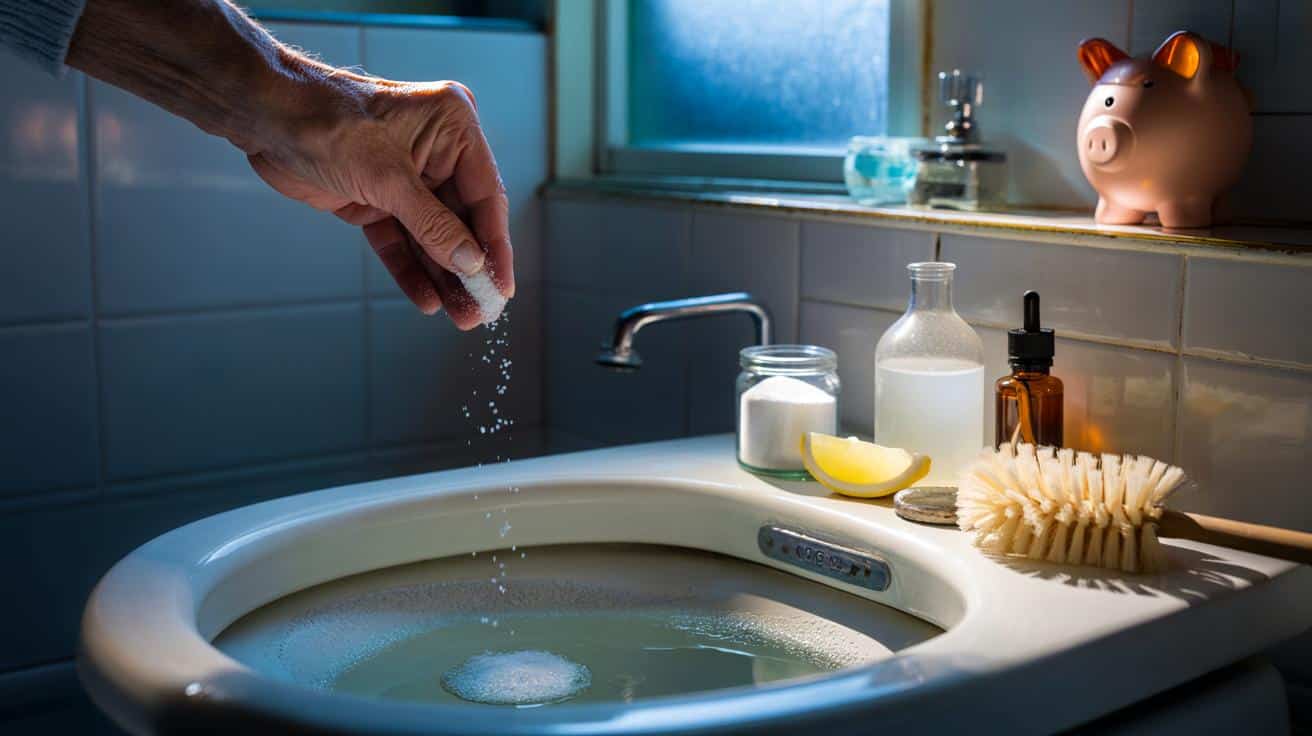An old-fashioned trick is back on British bathrooms’ radar: a pinch of kitchen salt, left to sit overnight in the bowl. People like the price and the promise of fewer harsh chemicals. Behind the nostalgia sits simple chemistry, clear limits, and a routine that works best when you use it sparingly and target the right problem.
Why grandmothers reached for salt
Salt offers gentle abrasion at the morning brush and can dull minor odours that form on the waterline. Night-time matters because the bowl sits still. That pause gives modest ingredients time to do their quiet work.
Households today want fewer aggressive cleaners and less packaging. Salt and bicarbonate live in most cupboards. They cost little. They do not fix everything. They set you up for a fresher first visit of the day.
Salt does not dissolve limescale. For scale, reach for white vinegar or citric acid, not sodium chloride.
How the night pause actually works
When the loo rests, evaporation slows and the water surface stays undisturbed. Coarse grains settle on the ring where splashes dry. In the morning, a firm brush uses that grit to lift light biofilm. A spoon of bicarbonate of soda raises pH around the surface, which can reduce sour odours from mild acidity. A few drops of essential oil add scent, nothing more.
None of this disinfects the bowl in any meaningful way. The mix freshens, helps the brush, and keeps streaks down between deeper cleans.
The gentle night method step by step
- Sprinkle 2 tablespoons of coarse salt into the bowl, aiming around the waterline.
- Add 1 tablespoon of bicarbonate of soda. Optional: 3–5 drops of essential oil on the sides.
- Do not flush. Leave it overnight for at least 6–8 hours of contact time.
- In the morning, brush the sides and under the rim with firm strokes, then flush.
- Repeat 1–2 times a week. More often brings no extra benefit.
Never pour boiling water into the bowl. Use hot tap water only to protect porcelain, seals and PVC.
What salt can’t do, and what to use instead
For limescale, use an acid
Scale needs acid. Pour 250–500 ml of white vinegar into the bowl and under the rim. Or dissolve 1–2 tablespoons of citric acid in 500 ml of warm water. Leave for 30–60 minutes, brush, then flush. In very hard water areas, plan this once a week to stop crusts forming.
For small soft clogs, go light and patient
If the bowl drains slowly, try half a cup of coarse salt followed by 1 litre of hot tap water. Wait 30–60 minutes, then flush once. This can help loosen light grease and soap residues. It won’t beat a solid blockage. Keep a plunger or an enzyme-based cleaner for tougher jobs. Avoid chemical cocktails that can release fumes.
Costs, timings and when to use what
| Task | What to use | Quantity | Contact time | How often | Rough cost |
|---|---|---|---|---|---|
| Overnight freshen | Coarse salt + bicarbonate + optional essential oil | 2 tbsp + 1 tbsp + 3–5 drops | 6–8 hours | 1–2× weekly | 10–20p per treatment |
| Remove limescale | White vinegar or citric acid solution | 250–500 ml or 1–2 tbsp in 500 ml | 30–60 minutes | Weekly in hard water | 8–30p per treatment |
| Ease light clog | Coarse salt + hot tap water | ½ cup + 1 litre | 30–60 minutes | As needed | 10–15p per attempt |
Safety notes most people miss
- Do not put salt or acids in the cistern. They can corrode bolts and tire seals.
- Keep essential oils away from children, pets and pregnancy. Fragrance-free works fine.
- Ventilate the bathroom for ten minutes a day to cut humidity and odours at the source.
- Use a brush with stiff bristles and rinse it after each use. Replace it every few months.
- Hard water leaves faster build-up. In those postcodes, schedule an acid clean every week.
The night method freshens and speeds your morning clean. The acid method removes scale. Use each for its job.
What this means for your routine
The average person spends about two and a half minutes per visit and makes around 2,000 trips a year. Small tweaks compound. An overnight salt-and-bicarb habit can cut scrubbing time and keep the bowl visually cleaner between deeper treatments. Pair it with a weekly vinegar or citric wash in hard water areas and you limit the need for harsher chemicals.
Budget-wise, the cupboard method costs pennies per week. If you switch from a branded gel to basic vinegar and bicarbonate for maintenance, the annual saving can run to several pounds while shrinking plastic waste. You also reduce strong scents that can irritate airways in small, unventilated rooms.
Extra tips to go further
To test whether you face hard water, check for a chalky ring that reappears within days. If it does, shorten the gap between acid cleans rather than adding more salt. For septic tanks, keep all treatments modest and avoid pouring concentrated disinfectants down the bowl, which can disturb the tank’s bacteria. If you share facilities, post a small card with the overnight plan so nobody flushes too soon.
Curious about effort versus reward? Try a two-week trial. Week one: routine clean only. Week two: add the night method twice and a single vinegar sit. Track brushing time and smell on waking. Most households report a quicker morning brush, fewer rings and lower spend. That is why your nan’s quiet trick still earns a place—used for the right reasons, on the right nights.








